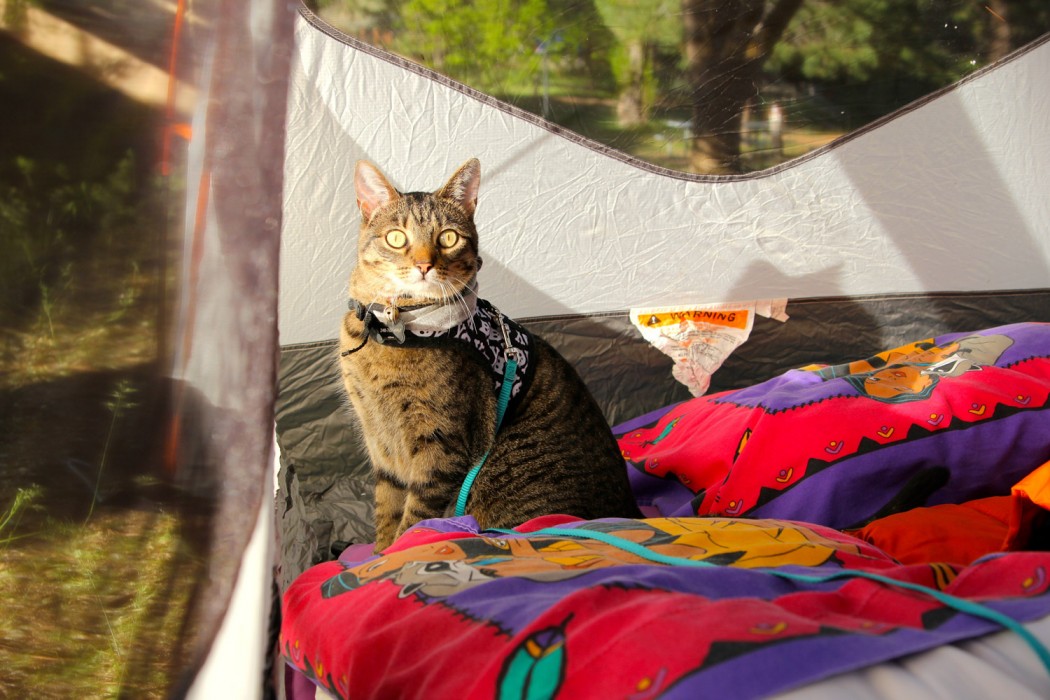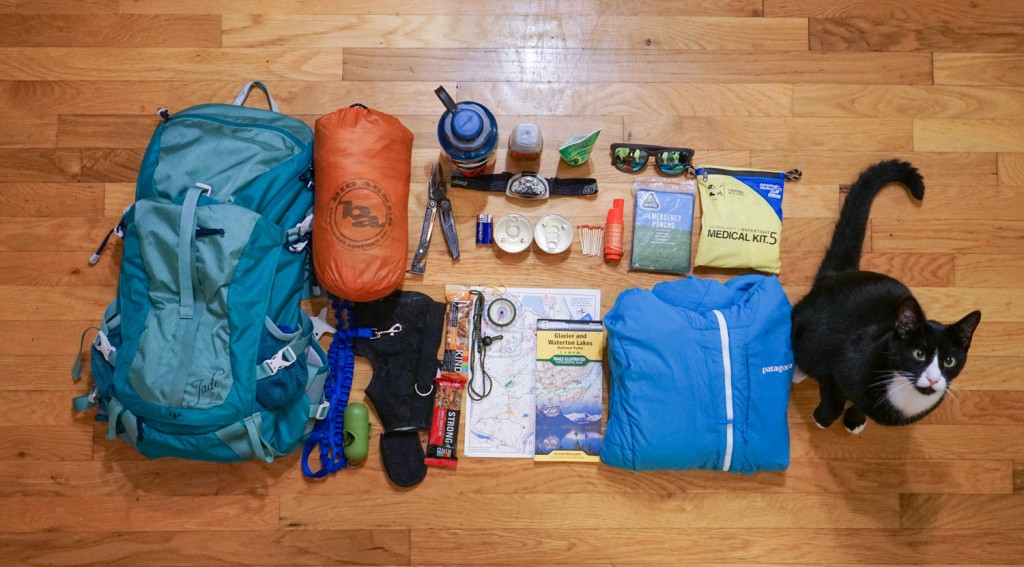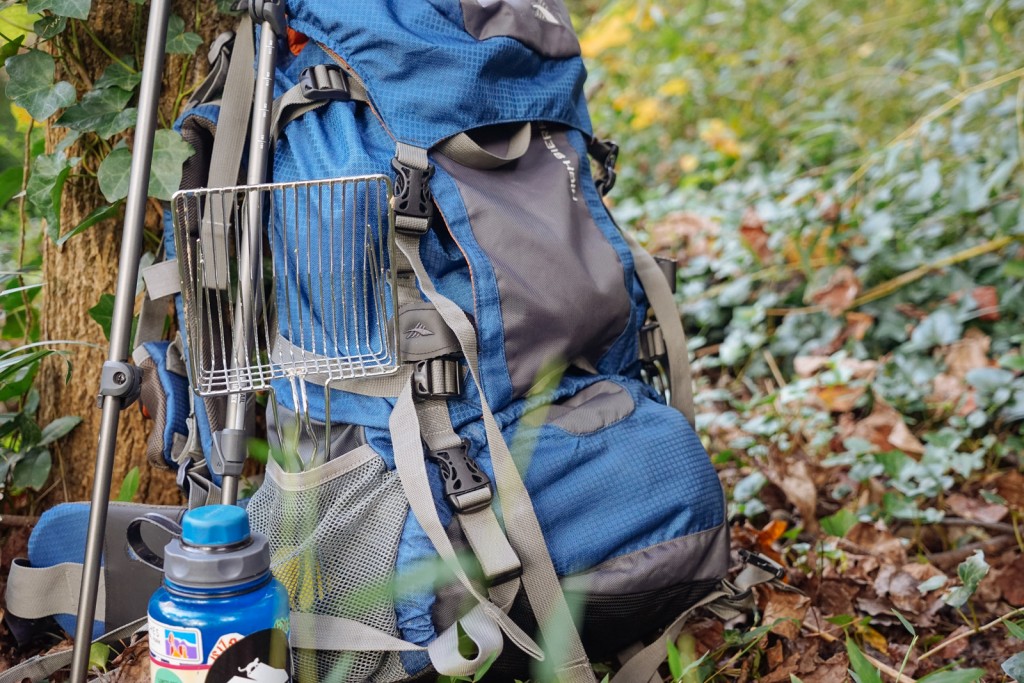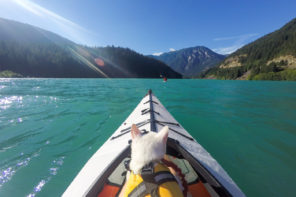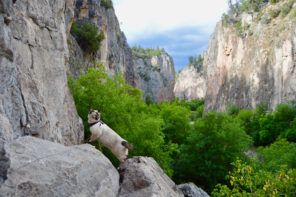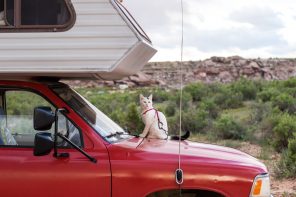Camping with cats? Yes, it’s possible. It’s also a great way for your feline friend to get some exercise and for the two of you to bond in the outdoors. However, you can’t simply attach a leash to your cat’s collar, pack an extra can of tuna and head into the woods with your little campurr. If you want to ensure that both you and kitty have an enjoyable time, it’s going to take a little planning and preparation.
If you’re new to the world of adventuring with a cat, we recommend you start by determining if your kitty is right for this type of lifestyle because if your cat doesn’t enjoy camping, you’re certainly not going to enjoy camping with your cat. (You kitty will make sure of that.)
“It’s absolutely true that this is not for every cat,” Dr. Kat Miller, director of ASPCA anti-cruelty behavior research, told Adventure Cats. “A feline must be easy to handle to get the harness on and off, confident enough to explore the outdoors without fear, and not so ‘squirrely’ as to try to wriggle out of a harness and make a break for it.”
So read up on the nine feline personalities to determine whether your cat could be an adventure cat.
Also, before you head outdoors even for a walk around the backyard with your kitty, make sure you’ve purchased the right type of harness and have properly leash trained your cat. Your kitty’s first trip into nature shouldn’t be when his paws hit the ground at the campsite.
While throwing you cat into camping may work out fine, most cats won’t respond well to being forced into a new situation, and it’s very likely your cherished pet could end up injured or even lost. So do this camping thing right and brush up on all the basics before you hit the trail.
Before you go
What kind of trip are you planning?
Will you be sleeping in a trailer or doing a little car camping with a tent nearby? Purrfect. A short hike to the campsite with a kitty accustomed to hiking? Totally doable. A 10-mile backpacking trip or a few months on the AT? Uh-huh. Don’t even think about it. Not even the meownificent Millie or badass Burma are putting in those kind of miles, so please don’t spring this kind of trip on your kitty.
Never taken your cat on a trail before? Here’s everything you need to know about hiking with cats.
Is your destination pet-friendly?
Do your research before you go, and call ahead if you’re not sure if cats are allowed. While some national parks allow pets on certain trails and in campgrounds, they won’t allow them in the backcountry. Pets are allowed in all U.S. national forests, but they’re expected to be on leashes in most places and aren’t permitted in swimming areas. Keep in mind that some campgrounds will charge extra if you bring along your cat.
How’s the weather?
Check the weather before you and your feline friend head outdoors, and don’t take your cat camping during extreme temperatures. Also, consider the length of your cat’s coat — or lack of coat — before heading out on a particularly hot or chilly day. If your cat is a hairless breed or has fine, light-colored hair, he may need sunscreen.
Pack the proper gear.
In addition to your own outdoor gear, you need to bring along all the necessary items for your four-legged friend. Check out our list of the 14 essentials to pack for camping with your cat, but familiarize yourself with some other important gear below.
A cat’s gotta eat.
Pack the exact same food that your kitty consumes at home to avoid any digestive issues, and bring enough for every day you plan to camp. Then bring a little extra just in case. Keep in mind that cats need about 250-300 calories a day to maintain their weight. (Not sure how much to feed your kitty? Every food is different, so refer to the food label or talk to your veterinarian.) Also, be a good parent and pack some treats to reward your kitty camper when he makes it to the campsite.
And yes, your cat’s food goes in the bear bag at night, too.
Keep your cat hydrated.
Bring plenty of water for both of you to drink, and don’t rely on wet food to keep your cat hydrated. Your cat needs fresh water — and no, not water from streams or ponds. Such water could contain parasites like Giardia or bacteria that can cause infections. If you wouldn’t drink that water, your cat shouldn’t either, so bring along a water filter or water-treatment drops if you won’t have access to potable water.
Safety furst.
In addition to that first-aid kit, make sure your cat’s harness and leash are outfitted with lights so he’ll be easy to spot should he get away. Or you could go the Burma the adventure cat method and outfit your cat’s collar with a radio transmitter; however, some LEDS and supervision should be all you need.
“Take LEDs to put on them at night, and keep these on all night in case you have to exit in emergency,” Craig Armstrong, Millie the climbing cat’s human, told Adventure Cats.
Also, never take your cat outside unless he’s vaccinated and on flea, tick and heartworm prevention treatment. And your cat should be microchipped and wearing a collar and tags.
Hopefully it never happens, but if your cat does go missing, be sure to have a recent cat photo on your phone to show people. (Admit it, your phone is already 90 percent cat photos anyway.)
What about a litter box?
While some cats have no qualms about doing their business in the woods, most cats prefer to have a litter box on hand so be sure to pack a small one you can fit in your tent. If you’re going to be in the car for a while, it’s a smart idea to also have access to one in the vehicle. Check out these adventure cat-approved suggestions for lightweight and collapsible reusable litter boxes, as well as disposable, biodegradable ones.
And if your kitty chooses to make the forest his litter box, clean it up just like you would with a dog. Cat feces can contain Toxoplasma gondii, a protozoan parasite that can infect any warm-blooded species. T. gondii has been linked to several health issues and can be particularly harmful to pregnant women.
The comforts of home
In addition to all the kitty essentials, bring a favorite toy or a familiar blanket to help your cat feel right at home in the tent.
Do you need a carrier?
Your cat should always travel in a carrier when you’re driving to your camping destination, and it’s a good idea to bring a carrier to your campsite as well. You likely don’t want to lug a large plastic carrier on the trail, so consider a soft-sided one that can collapse or lie flat. These type of carriers are great for camping because they provide a comfortable place for your cat to nap at night, as well as a safe place for your cat to retreat to. Burma sleeps in a carrier beside Stephen Simmons at night, so clearly it’s a practice even the most adventurous of kitties can adjust to.
You may instead choose to have your kitty snuggle up in your sleeping bag with you at night, but keeping the carrier inside the tent is a good idea in case of an emergency.
Do a test run.
If your cat has never been in a tent before, it won’t hurt to get him used to it in the yard or even inside your home. Set up the tent and let your kitty get a feel for his new sleeping quarters.
At the campsite
Keep your cat on a leash.
Don’t let your cat roam the campground by himself. Keep him on a leash or in a carrier. This is the best way to ensure your cat doesn’t wander off and encounter wildlife, eat something he shouldn’t or get into another dangerous situation.
Don’t tie your cat up and leave him.
Never tie your cat’s leash to something and leave him unsupervised. However, while you’re setting up camp, Caitlin Seida of Catster suggests setting up a picket line. “Pack a length of clothesline and tie it to two trees,” she writes. “Clear the area beneath the trees and hitch up your cat’s harness and leash to the picket line. This allows her to move freely and explore as you go about your work. Do keep an eye on her, though, to make sure she isn’t getting tangled or her harness isn’t coming loose.”
If your cat somehow does get off leash, you’ll be relieved that you trained him to come when called. If for some reason your kitty makes a dash for it, know what to do if your cat gets away.
Keep a close eye on your kitty.
From insects and plants to new scents and sounds, there’s going to be a lot going on at the campsite that your cat will want to check out. Let him engage his curiosity, but do it under your constant supervision.
Don’t let your cat munch on potentially dangerous plants, and keep an eye out for other campground pets, as well as wildlife. Your feline may be fierce, but dangers can lurk under rocks as well as in the sky. Eagles, hawks and even large owls can pose a serious danger to an unsupervised cat.
Watch that campfire.
Your kitty may be intrigued by the fire and want to check it out, so be aware of where he is in relation to it. While your cat is likely smart enough not to get close enough to singe his whiskers, he may not be aware of the location of his leash so it’s your responsibility to ensure that the end doesn’t get too close to where you’re making s’mores.
Maintain your usual schedule.
Cats are autonomous animals, but just like us they can find comfort in ritual, so don’t change your cat’s schedule just because you’re in the great outdoors. Feed your kitty at the same time of day, clean the litter box daily if that’s what he’s accustomed to, and climb into the sleeping bag at your usual bedtime.
Provide a safe place for your cat.
Whether it’s a carrier or an open car door, your feline friend should have a place where he can run if he gets off leash or becomes spooked.
“I think having the open tent door or the open truck doors, somewhere familiar with familiar smells and what not, really helps [our cat] to relax outside and enjoy camping as much as we do,” Haley O’Rourke, who camps with her cat Pistachio, told Adventure Cats.
Let’s emphasize this again: Never leave your cat alone.
It doesn’t matter if you’ve zipped your kitty into the tent or enclosed him safely in his carrier, don’t leave your cat alone at the campsite. If you want to engage in cat-less activities on your camping trip, then leave your kitty safely at home.
Remember that a cat can change the nature of your camping trip.
Cats can definitely enhance your outdoor experience. It can be magical to watch them interact with nature and downright comforting to have a kitty curled up on your lap beside the campfire.
“Quandary loves watching the birds, bugs and fire crackle,” Erin Verplaetse told Adventure cats. “She sleeps like a rock, snuggled in my bag with me at the end of the night.”
Plus, cats can clue you in to parts of the natural world you might have overlooked, according to Craig Armstrong, who frequently camps with his cat, Millie.
“You see things you would not otherwise see,” he said. “You get lower to the ground, you move slower, you notice things she checks out that you would have walked right past.”
However, there are drawbacks to camping with cats because it puts limitations on what you can do. After all, just like at home, your cat will be the one calling the shots. And as all good pet parents are conscientious, having your fur baby with you in the outdoors can cause a bit of anxiety.
“I’d say the only disadvantage there is to camping with Stash is that sometimes I can’t fully relax because I’m constantly making sure he hasn’t gotten too comfortable and wandered off into the woods,” said O’Rourke. “Even though he sticks around the truck and never has gone too far. I am slightly obsessed with my cat and, like a lot of pet owners, think of him as my child.”
Be sure to take all of this into consideration before going camping with your cat.
Have fun!
Now that we’ve got all that important safety and preparedness information out of the way, let’s just say that you’re going to have a meownificent time. After all, you’re camping with your cat!
Before you take your cat outside, please familiarize yourself with these adventuring best practices.

